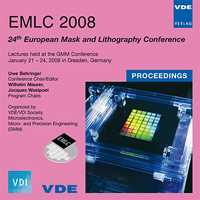45nm Node Registration Metrology on LTEM EUV Reticles
Konferenz: EMLC 2008 - 24th European Mask and Lithography Conference
21.01.2008 - 24.01.2008 in Dresden, Germany
Tagungsband: EMLC 2008
Seiten: 8Sprache: EnglischTyp: PDF
Persönliche VDE-Mitglieder erhalten auf diesen Artikel 10% Rabatt
Autoren:
Laske, Frank; Czerkas, Slawomir; Schmidt, Karl-Heinrich; Adam, Dieter; Roeth, Klaus-Dieter (Vistec Semiconductor Systems GmbH, Kubacher Weg 4, D-35781 Weilburg)
Kinoshita, Hiroshi; Nishida, Naoki; Kenmochi, Daisuke (Hoya Corporation, 1375, Kawaguchi-Cho Hachioji-Shi, Tokyo 193-8525 Japan)
Ota, Hitoshi; Tanioka, Yukitake (Dainippon Screen Mfg.Co.Ltd., 3-23-14, Higashi-ikebukuro Toshima-ku, Tokyo 170-0013 Japan)
Inhalt:
Reticles for the 65nm technology node are already in production and leading edge mask shops will complete R&D for 45nm technology node reticles very soon. The specifications for registration for this new node are expected to be much tighter than for previous generation reticles. New generation lithography (e-beam) tools will become available soon to support the writing accuracy as required for 45nm node reticles. Tighter registration tolerances require a next generation registration metrology tool, providing measurement performance to fulfill the specification of 45nm node and beyond. EUV lithography might become the backup solution for next generations 32nm and 22nm nodes in order to overcome the resolution limits of optical lithography. Considering the extremely tight mask to mask overlay tolerances of EUV reticles, we will demonstrate the performance of the LMS IPRO4 for registration metrology on EUV masks. We will present the actual system performance of the LMS IPRO4 on high-end Hoya EUV masks with various substrate materials. A detailed analysis of measurement precision and accuracy performance of the new LMS IPRO4 will be provided. Additionally, we will present a comparison of measurement performance of EUV masks from quartz and EUV masks from new LTEM material used as substrate. LTEM substrate enables to analyze soaking effects related to temperature differences between stage and the mask itself. Results of an experiment will be shown, where we compare the soaking time needed before starting the measurement process using quartz material and LTEM.


